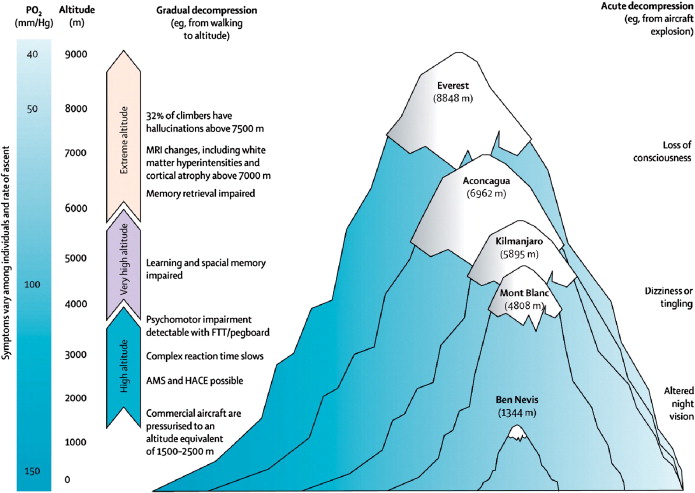High Altitude Illness: Symptoms, Causes, Treatment
What are the symptoms of high altitude illness?
High altitude illness, also known as acute mountain sickness (AMS), is a condition that can occur when you travel to a high altitude too quickly. Symptoms typically develop within hours to days of reaching high altitudes and may include:
- Headache: This is one of the most common symptoms of AMS and is often described as a throbbing or pounding sensation.
- Fatigue: Feeling unusually tired or weak is common at high altitudes.
- Dizziness or lightheadedness: You may feel dizzy or like you are going to faint.
- Nausea or vomiting: Some people experience stomach upset or vomiting.
- Loss of appetite: You may not feel hungry or may have a decreased desire to eat.
- Difficulty sleeping: Many people have insomnia at high altitudes, which can contribute to feelings of fatigue.
- Shortness of breath: You may feel like you’re not getting enough air, especially with exertion.
In more severe cases, high altitude illness can progress to a condition called high altitude cerebral edema (HACE) or high altitude pulmonary edema (HAPE), which can be life-threatening. Symptoms of HACE include confusion, hallucinations, clumsiness, and difficulty walking. Symptoms of HAPE include severe shortness of breath, coughing up pink or frothy sputum, and chest tightness or congestion.
If you experience symptoms of high altitude illness, it’s important to descend to a lower altitude as soon as possible and seek medical attention from a healthcare provider if symptoms are severe or do not improve with descent.
What are the causes of high altitude illness?
High altitude illness, including acute mountain sickness (AMS), high altitude cerebral edema (HACE), and high altitude pulmonary edema (HAPE), is caused by the decreased oxygen levels and changes in air pressure that occur at high altitudes. When you travel to a high altitude too quickly, your body may not have enough time to acclimatize to the lower oxygen levels, leading to symptoms of high altitude illness.
Some of the factors that can increase your risk of developing high altitude illness include:
- Rapid ascent: Climbing to a high altitude too quickly does not give your body enough time to adjust to the lower oxygen levels.
- High altitude: The risk of high altitude illness increases with higher altitudes. AMS can occur at altitudes as low as 2,500 meters (8,200 feet), while HACE and HAPE are more common at altitudes above 3,000 meters (9,800 feet).
- Individual susceptibility: Some people are more susceptible to high altitude illness than others, regardless of their fitness level or previous altitude experience.
- Dehydration: Not drinking enough fluids at high altitudes can increase your risk of developing AMS.
- Exertion: Overexertion at high altitudes can increase your risk of developing high altitude illness.
- Personal factors: Factors such as age, sex, and pre-existing medical conditions can also influence your risk of developing high altitude illness.
It’s important to acclimatize properly when traveling to high altitudes and to ascend gradually to allow your body time to adjust to the lower oxygen levels. Drinking plenty of fluids, avoiding alcohol and tobacco, and getting plenty of rest can also help reduce your risk of developing high altitude illness.
What is the treatment for high altitude illness?
The treatment for high altitude illness depends on the severity of the symptoms. For mild cases of acute mountain sickness (AMS), the following steps may be recommended:
- Rest and acclimatization: Resting at the same altitude until symptoms improve is often the first step. Avoiding further ascent until symptoms have resolved is important.
- Hydration: Drinking plenty of fluids can help alleviate symptoms and prevent dehydration, which can worsen AMS.
- Pain relief: Over-the-counter pain relievers, such as ibuprofen or acetaminophen, can help alleviate headache and other mild symptoms.
- Supplemental oxygen: In more severe cases of AMS, supplemental oxygen may be needed to increase oxygen levels in the blood.
For more severe cases of AMS, as well as for high altitude cerebral edema (HACE) and high altitude pulmonary edema (HAPE), immediate descent to a lower altitude is the primary treatment. Descent is the most effective way to rapidly increase oxygen levels in the body and alleviate symptoms.
If descent is not immediately possible, or if symptoms are severe, medical treatment in the form of medications and oxygen therapy may be necessary. Medications such as dexamethasone or acetazolamide may be prescribed to help reduce swelling in the brain or improve breathing.
It’s important to recognize the symptoms of high altitude illness and to descend or seek medical attention if symptoms are severe or do not improve with rest and hydration. Prompt treatment can prevent the progression to more severe forms of high altitude illness and can be life-saving.




